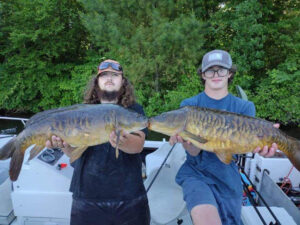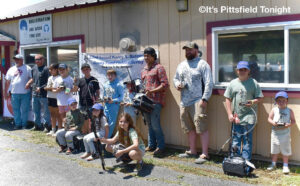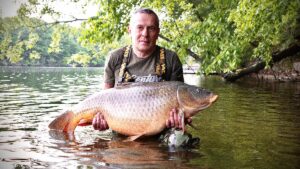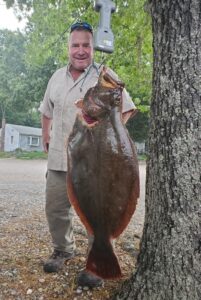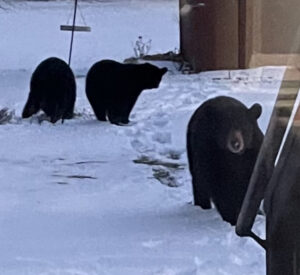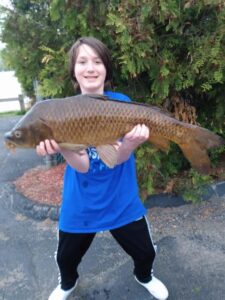On Saturday, June 15, the Carp Palooza fishing derby was held on Pontoosuc Lake. According to organizer Josh Christman, this was a record year with 37 teams. Robert Houghtlin and Payton Quinn were this year’s champions. They had a total weight of 29 lbs, with the lunker being over 15 lbs. They received the winning belts and over $1,000 for having won the tournament and the Lunker Pool which is the heaviest carp.
With an earlier start time, they saw teams with their kids making a day of it. Christman plans the same start time again next year because people enjoyed the earlier time start. Next year he also hopes to add a kid’s division so they can also participate. This year he awarded a child a gift card because the father sent Christman the video of the child catching a carp. “It was great seeing people participate as a family.” said Christman. He said that from now on, the derby will be moving to Onota Lake permanently.
Raffles were offered this year and they were able to raise over a $1,000 which was handed to Steve Bateman to be added to the donations for the Jimmy Fund.
Christman thanked the sponsors: Berkshire Tree Service, Lakeside Bar & Grill, Onota Boat Livery Jsmegal Roofing & Gutters, Dave’s Sporting Goods and Dicks Sporting Goods. He also gave a huge thank you to Steve Bateman, Brandon Murray, Andrew Christman and Conor Graham for helping out with Carp Palooza this year.
An Act Modernizing Firearm Laws
Recently, the MA House of Representatives and Senate voted on H.4885 (An Act Modernizing Firearm Laws). The House vote was 124 yeas, 33 nays and 2 not voting. State Representatives Barrett and Farley-Bouvier voted yea and Pignatelli did not vote. The Senate vote was 35 yeas and 5 nays. State Senator Mark voted yea.
Incidentally, after many years Smitty Pignatelli is not seeking re-election and there are currently 4 candidates running for his seat. Before casting your vote this November, perhaps you should find out how each one would have voted on H.4885.
It is quite lengthy (116 pages) and, at the time of this writing, is still being reviewed by GOAL (Massachusetts Gun Owners Action League) and others. It would be impossible for me to delve into it as it is so lengthy it would take several columns to list and explain its contents. Also, I am receiving conflicting information as to what exactly is in that bill and am afraid to comment on it at this time for fear my information may be inaccurate and would only add to the confusion.
I’m not hearing good things about some aspects of it. For starters, according to Mass Conservation Alliance (MCA) Co Chair Wayne M. Adams, one now must have an LTC (license to carry) in order purchase, possess, transfer, etc. all semi-automatics firearms. ( A LTC costs $100.00 and must be renewed every 6 years.) FID card holders are banned from privately transferring or purchasing 1) large capacity firearms and feeding devices and 2) all semi-automatic firearms.
In the upcoming weeks, this column will provide more information on the many aspects of this bill. I doubt this new law will change anything and only the law abiding gun owners will abide by these laws and that it will have little or no effect on people with evil intentions.
The Landship Partnership Program
The Healey-Driscoll Administration recently announced over $3 million in grants to conserve large acreages of essential land across Massachusetts. Through the Landscape Partnership Program, the Executive Office of Energy and Environmental Affairs (EEA) awarded three grants to expand public recreational opportunities, improve water supply protection, support agriculture, and promote healthy ecosystems. The grants from the program will also support the Forests as Climate Solutions Initiative to protect high-quality forested land.
“Investments in land conservation are critical to strengthening climate resilience in our communities. Thoughtfully conserving our natural landscapes is also essential for reducing emissions and safeguarding the diversity of our ecosystems,” said EEA Secretary Rebecca Tepper. “Successful partnerships between agencies and organizations such as these can have a profound impact on enabling residents to enjoy the outdoors.”
The Landscape Partnership Grant Program was established in 2011 to facilitate large-scale projects that foster healthy ecosystems, protect the viability of farm and forest economies, and expand public outdoor recreational opportunities via state, municipal, and non-profit partnerships. This year’s awards will conserve over 1,300 acres in Berkshire and Plymouth County. The implementation of these grants will support the administration’s efforts toward building climate resilience and safeguarding critical natural landscapes.
“I want to thank Secretary Tepper and the Healey-Driscoll Administration for making this important investment into crucial land conservation efforts in Southeastern Massachusetts,” said Senator Marc R. Pacheco (D-Third Bristol and Plymouth). In addition to ensuring healthy ecosystems, protecting water supply, and creating recreational opportunities, these grants protect areas that, through carbon sequestration, play a part in the Commonwealth’s efforts to meet their requirement of being Net-Zero by 2050.”
One of the Landscape Partnership Grant Program awardees is The Trustees of Reservations, Sheffield Land Trust, and MA Department of Agricultural Resources (MDAR) – Cooper Hill Farm Project. A $1.25 million grant to protect 538 acres that are part of a broader, regional effort to conserve 1,130 acres of critical ecological habitat, forestland, and active agricultural landscapes in Sheffield, MA and Salisbury, CT. The Project will purchase an Agricultural Preservation Restriction (APR) from Pine Island Farm, one of the largest dairy farms in Massachusetts, ensuring the farm remains in agricultural use in perpetuity. The project will also extend protection to 40 acres of MassWildlife’s Natural Heritage and Endangered Species Program (NHESP) designated Priority Habitat for Rare Species and expand public enjoyment of Bartholomew’s Cobble which is managed for passive recreation and habitat values by The Trustees of Reservations.
The other two grant awardees are: Buzzards Bay Coalition, Town of Carver and Town of Wareham – Weweantic River Headlands Conservation Project: $1.25 million to protect 280 acres of forested uplands, cranberry bogs, and riparian wetlands along the mainstem of the Weweantic River in Carver and Wareham.
Buzzards Bay Coalition and MA Department of Fish & Game (DFG) Division of Fisheries & Wildlife (MassWildlife) – Sippican Headwaters Landscape Project: $1.25 million to protect 499 acres of forested uplands and wetlands at the headwaters of the Sippican River in Rochester and Middleborough.
12-Pound, 6-Ounce Largemouth Bass Breaks 37-Year NY State Record
Recently, New York State Department of Environmental Conservation (DEC) Interim Commissioner Sean Mahar announced that a new state record for largemouth bass was set on July 11, 2024. James Britenbaugh of Pennsylvania reeled in the record-breaking 12-pound, 6-ounce largemouth bass from Cayuga Lake, Cayuga County while fishing in preparation for an upcoming bass tournament. The record-breaking catch surpasses the previous 37-year-old State record largemouth bass, caught from Buckhorn Lake, Otsego County, in 1987 by one pound and two ounces.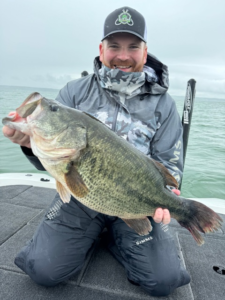 James Bitenbaugh.
James Bitenbaugh.
“It’s no secret that New York has the best bass fishing opportunities in the country and Mr. Britenbaugh’s incredible fish certainly confirms that,” Interim Commissioner Mahar said. “DEC encourages all anglers fishing in New York to check out the Angler Achievement Awards Program before dropping a line in the water. It’s an exciting program that recognizes sizable catches and shines a light on the numerous lakes, rivers, ponds, and streams producing trophy-sized fish right here in New York.”
This year, New York State landed five lakes on Bassmaster Magazine’s Top 100 Best Bass Lakes in the country. Among the New York waters included are the St. Lawrence River (Thousand Islands), ranked as the best bass water in the nation, and Lake Erie/Upper Niagara River, ranked as the seventh-best water. Lake Champlain, Cayuga Lake, and Oneida Lake made the list as well and are in Bassmaster Magazine’s Top 25 Northeastern Best Bass Lakes of 2024. Other waters across the state also offer exceptional bass opportunities and New York continues to be a destination for world class fishing.
Incidentally, the state record for largemouth bass in Massachusetts is 15 lbs, 8 oz and it measured 28 inches. It was caught out of Sampson Pond in Carver by Walter Bolonis in1975.
Bateman Memorial Fund Fishing Derby breaks another record
According to event organizer Steve Bateman, the 32nd annual Harry A. Bateman Memorial Fund Fishing Derby was a huge success this year mainly in part because of all the great sponsors that supported the event and the great team that put this event on. The derby, which was held on June 1, had another record-breaking year with attendance and funds raised. Some 330 registered anglers plus another 30-40 people. They raised a record-breaking $13,500+ for the Jimmy Fund.
The largest fish weighed in was a 16 lbs. 4 oz Common Carp caught by Joe Trybus. This was also the largest fish ever weighed in the history of the fishing derby.
New to the derby’s sponsors this year was Joe Garzone of Berkshire Taxidermy who was kind enough to mount the winning trout in the children’s category. Certainly a gift to remember for a lifetime. They also had Chuck Maces of Maces Marine who donated the use of a pontoon boat for the entire day. Carlo Torra and John Erbin from COBB of Western MA brought children and parents throughout the day to experience fishing from a boat. For some it was their first time.
Free worms were provided by Onota Boat Livery. Mayor Peter Marchetti, Councilor Pete White and former Councilor Karen Kalinowski were in attendance. “There was so much support from our community that people from all over the county and other states attended this event,”said Bateman, “two people in attendance, Joe Monterosso and Sue Crawford, traveled in their electric wheelchairs, a 6 mile round trip for the 2nd year, to come to the fishing derby.”
Bateman feels that transportation for the handicapped community will be something that needs attention for next year’s Fishing Derby.
A great time was had by all.
This year they had several repeat winners at this event. The winners as reported by Steve are as follows:
CHILDREN HEAVIEST GAME FISH CATEGORY
1ST. PLACE: MASON KUCKA – NORTHERN PIKE 3 LBS. 13 OZ.
2ND. PLACE: QUINTYN SHUTTLEWORTH – LARGEMOUTH BASS- 2 LBS. 6 OZ.
3RD. PLACE: MILA OSTELLINO – RAINBOW TROUT – 1 LBS. 11 0Z.
CHILDREN HEAVIEST NON-GAME FISH CATEGORY
1ST. PLACE: CLOE SHUTTLEWORTH – BOW FIN – 6 LBS
2ND. PLACE: RAYCHELLE ERRICHETTO – BULLHEAD – 13 OZ.
3 RD. PLACE: CASSIDY WOJNICKI – BULLHEAD – 11 OZ.
ADULT HEAVIEST GAME FISH CATEGORY
1ST. PLACE: JORDAN PASQUARELLI- LARGEMOUTH BASS- 2 LBS. 10 OZ.
2ND. PLACE: DA’JAUN MERENDA– CHAIN PICKEREL – 1 LBS. 13 OZ.
3RD. PLACE: MIKE STORIE – LARGEMOUTH BASS- 1 LBS. 12 OZ.
SPECIAL HEAVIEST FISH 1ST. PLACE AWARDS
BASS: JIM BAK-LARGEMOUTH BASS – 3 LBS. 3 OZ. ADULT
PERCH/CRAPPIE: NICK SAYERS – CALICO BASS – 11 OZ.
CARP: JOE TRYBUS- COMMON CARP- 16 LBS. 4 OZ.
TROUT ADULT: JAKE BURKE – RAINBOW TROUT 2 LBS. 5 OZ.
CHILDREN TROUT: ALICE CHRISTMAN – RAINBOW TROUT 1 LBS. 12 OZ.
SPORTSMANSHIP AWARD: DELCAN ABLE
BUTCH PATRICK TACKLE BOX: JULIANNA MATTHEWS
RAFFLE: 55” TV – DAVID HUBBARD
$100 LOTTERY TREE- KIM SORRENTINO
50/5O RAFFLE PAID OUT $385
ADULT DOOR PRIZE: GAS GRILL IN MEMORY OF CARL DELUCE: ALBERT ADAMS
Cindy Delpapa honored
The Wild & Scenic Westfield River Committee recently awarded Cindy Delpapa, of Becket the Bob Thompson award for her dedication to the river and the breadth of knowledge she shared for the benefit of all. The news release mentioned “her high standards and clarity of focus guided the committee through an update of the strategic plan, development of a website focused on action, and a model for funding culvert replacement across the watershed that improves safety and river habitat at the same time.”
“Cindy was instrumental in launching two new initiatives, “Rooting out Barberry” and exploring “Brine for Pretreatment” to prevent ice from forming on our Hilltown roads in winter. Cindy brought Action Research in to assist the committee with developing campaigns that speak directly to the audience the committee is trying to reach in a manner that is clear, inspiring and motivating.
If you are interested in the committee’s work or participating in its initiatives visit https://westfieldriverwildscenic.org/.
Meredyth Babcock, volunteer and projects coordinator for the Wild & Scenic Westfield River Committee, gives us more information about Cindy. “After more than 25 years of service to the people of Massachusetts, the Department of Environmental Restoration’s (DER) Cindy Delpapa retired in late 2021. Cindy brought wide and deep expertise in water quality, stream ecology, estuarine ecology, regulatory policy, and grass-roots action to the Riverways Program and DER. She focused on urban river revitalization, streamflow restoration, and water quality restoration; however, she was truly interdisciplinary, always asking herself what the rivers need and adapting her work accordingly. In addition to her subject matter expertise, Cindy brought exceptional compassion to her work.”
“Always modest, Cindy would be surprised to know that she was perceived as a role model and mentor by many at DER. Countless rivers and wetlands benefited from her restoration expertise. We miss her wisdom and knowledge daily and wish her the best in her new adventures.”
Advice on consuming our local fish
The Massachusetts Department of Public Health samples the water and fish throughout Massachusetts for high levels of mercury and forever chemicals known as PFAS. The Mass. DPH then issues advisories for what fish should not be eaten based on where they are caught.
Mercury is a naturally occurring metal that is found in the environment but can also be released by coal-burning power plants. Fish with mercury can still be consumed in some cases but should be limited to less meals per month.
PFAS, Per- and poly-fluoroalkyl substances, are chemicals that have been used since the 1950s for stain-resistant, water-resistant and non-stick products. PFAS are commonly used in food packaging, clothing and other products. One source of contamination has also come from firefighting foam. Consuming these forever chemicals over an unknown amount of time has been associated with increased levels of cholesterol and live enzymes as well as an increase in the risk of high blood pressure and pre-eclampsia in pregnant women.
There is no way to remove these chemicals from fish already contaminated. They can not be cut, cleaned or cooked out, according to DPH.
The following bodies of water in Berkshire County have been issued advisories as of May 2024. If you are more sensitive to these types of hazards, it is recommended to avoid eating any of these fish:
Ashley Lake in Washington – Mercury Hazard – Limit Yellow Perch to 2 meals/month
Ashmere Lake in Hinsdale – Mercury Hazard – Limit Chain Pickerel, Largemouth Bass to 2 meals/month
Big Pond in Otis – Mercury Hazard – Do not eat Largemouth Bass, limit other fish to 2 meals/month
Buckley Dunton Lake in Becket – Mercury Hazard – Do not eat Largemouth Bass
Garfield Lake in Monterey – Mercury Hazard – Limit Largemouth Bass to 2 meals/month
Goodrich Pond in Pittsfield – PCBs Hazard – Do not eat any fish
Hoosic River in North Adams, Williamstown – PCBs, PFAS Hazard – Do not eat any fish
Housatonic River – PCBs Hazard – Do not eat any fish including frogs and turtles
Konkapot River in Sheffield, New Marlborough – Mercury Hazard – Limit all fish to 2 meals/months
Morewood Lake in Pittsfield – PCBs Hazard – Do not eat any fish
Otis Reservoir in Otis, Tolland – Mercury Hazard – Limit all fish to 2 meals/month
Plunkett Reservoir in Hinsdale – Mercury Hazard – Limit Largemouth Bass to 2 meals/month
Pontoosuc Lake in Pittsfield, Lanesborough – Mercury, PFAS – Limit Largemouth Bass to 2 meals/month, limit other fish to 2 meals/month
Silver Lake in Pittsfield – PCBs Hazard – Do not eat any fish
Upper Spectacle Pond in Otis, Sandisfield – PFAS Hazard – Limit all fish to 1 meal/week
Windsor Lake in Windsor – Mercury Hazard – Do not eat Largemouth Bass
The good news is that MassWildlife stocks local lakes and rivers with healthy trout twice a year which can be consumed.
Pittsfield Open Space & Recreation Survey
Pittsfield is updating its Open Space & Recreation Plan (OSRP) and needs your help. Your input will help guide the planning process and determine the future of recreation and open space in the city. The plan will make Pittsfield eligible for state reimbursement grant programs for the improvement of recreation areas and the protection of open spaces.
The survey, which will be open from June 6 to July 7, has questions that may be of interest to Pittsfield hunters and fishermen, so you might want to make your voice heard. The questionnaire is open to all residents, and responses will be confidential. Click onto https://www.surveymonkey.com/r/PittsfieldOSRP.
Joe Areno’s Legacy lives on
I think I first met Joe Areno, of Pittsfield, sometime in 1980 when I attended a Pittsfield Sportsmen’s Club (PSC) venison heart and liver dinner. At that time the club was having various fund raisers to help pay for properties that it acquired on Potter Mountain. The land was to be used for hunting and recreation. Joe was a director of the club who coordinated the event which drew large crowds and the tickets were hard to get.
Joe was well known in the outdoor sporting community as one who was instrumental in dealing with local, state, and federal agencies to help institute legislation that protected open space throughout the county and state and legislation to help protect sportsmen’s rights to hunt and fish. Because of those efforts, Joe was named the Berkshire County League of Sportsmen (BCLS) 2002 Sportsman of the Year. In acknowledging him, the League pointed out that (at that time) he had served on the Board of Directors of the PSC in every position for over 45 years. “Many times he traveled down to Boston at his own expense to meet with Senators and Representatives to express views on how to protect the habitat and wildlife of this great Commonwealth.”
Sometime around 2008 or 2009, Joe was diagnosed with terminal cancer and one day, when he was quite ill, his wife Doris called me and said that Joe was nearing death and that he wanted me to stop by and see him. He wanted one final chat and to give me something. Oh, how I dreaded it, but I thought the world of him and did visit him. We had a good chat and I remember him saying something to the effect that he had no complaints and that he had a pretty good life. (Even though he served in the Korean War and was a decorated veteran). After having a sad but pleasant conversation, we said our final good byes. That was tough.
When I was leaving, Doris told me that there was some fishing stuff that Joe wanted me to have. One of the items was a bamboo fly rod that Joe had purchased in 1955 in Japan when he was on R&R from Korea. I told Doris that I couldn’t take that rod but rather it should be kept in the family to be given to one of his kids or grandkids. Doris said that nobody, kids or grandkids, flyfished and that Joe really wanted me to have it and some boxes of flies. Doris said that it was one of Joe’s final requests that I have it. Reluctantly but graciously, I accepted it while silently resolving that before I pass beyond the riverbend, that rod must somehow be returned to the family.
After leaving their house, I headed for the East Branch of the Westfield River, below Chesterfield Gorge in Chesterfield to meet fishing buddy, Doug Yates and do some flyfishing. Upon arrival, I saw Doug fishing downstream and waved to him to let him know I had arrived. I didn’t immediately join him for I wanted to be alone for a while after experiencing what had just transpired. Honoring Joe, I opted to use his bamboo rod instead of my own. With teary eyes I rigged up Joe’s rod and entered the river.
How appropriate it was that shortly thereafter, I caught a nice rainbow trout using that rod. This is for you, Joe, I thought. Unfortunately, I never got to see Joe again and tell him about it, for he passed away shortly thereafter.
In Joe’s honor, I created a bucktail style fly which I named Areno’s Legacy. A half dozen of them were raffled off at the next sportsmen’s banquet and his close friend the late Cleante ‘Clem’ Caryofilles of Pittsfield scoffed them all up. The ingredients for tying the fly are listed below.
Over the course of the next 15 years, I periodically fished with the bamboo rod. When using it, I always thought of Joe, and commonly referred to the fishing trips as fishing with a friendly spirit (Joe’s spirit).
Jump forward to this past May 11 Wild Acres Youth Fishing Derby. While covering the event for this column I spoke to quite a few anglers, mainly parents with their kids. One time, I stopped and talked with a pleasant young woman named Jessica Porter who was there with her 17 year old daughter Chalyce and 12 year old son Chase. While chatting with her, I mentioned that it just wasn’t the same this year without Clem Caryofilles of the Onota Fishing Club being there. He always assisted in this event, but sadly he passed away earlier this year.
Jessica replied that she knew Clem well and that he frequently fished and hunted with her father and grandfather. When asked who they were, she said her dad was Chris Porter and her grandfather was Joe Areno. Whoa! Joe Areno’s great grandson was there fishing?
I mentioned the fly rod and my desire to get it back to the family and wondered whether her son would want it. She immediately responded yes, but she would hold it for him until he gets older and appreciates what it is that he has. I told her that along with the rod, he’ll receive two boxes of flies that were Joe’s (Joe had etched his name on those fly boxes) and an Areno’s Legacy fly.
On May 29, the fly rod, Joe’s Pflueger Medalist fly reel and the flies were delivered to Chase. Now, Joe’s bamboo flyrod is in good hands, for he loves to fish. I really feel good about that, and I’d bet Joe does, too. 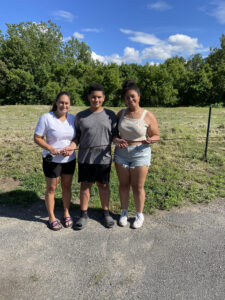
Incidentally, while delivering the rod, I learned that Chase was quite a young outdoor sportsman. He had also inherited Joe’s archery equipment including his bow, arrows and targets. (The arrows had Joe’s name printed on them). He, his mom and sister Chalyce are members of an archery league taught by Mark Jester at the Lenox Sportsmen’s Club. He has already received an Archer’s Perfect Score award. The folks at the Lenox Sportsmen’s Club are pretty high on him and are sponsoring him to attend the two week Mass Junior Conservation Camp later this summer. I’ll bet Joe feels good about that, too.
Rest assured Joe, your legacy lives on.
Areno’s Legacy fly
Hook: Size 6, 4X L streamer hook
Tail: Gray squirrel tail – represents the squirrel tails that Joe gathered up and kept in his freezer for his fly tying friends. (He may also have provided some to Mepps Company for their spinning lures. Each year Mepps put out a public call for squirrel tails and Berkshire Eagle Outdoor Columnist Ted Giddings included it in his column.)
Body: Rabbit fur dyed forest green signifying Joe’s love for rabbit hunting and his efforts to restock club property with snowshoe hares. It also signifies the many acres of forest that Joe helped to procure for the Pittsfield Sportsmen’s Club, making it the club with the most landholdings in Massachusetts. Through his efforts, nearly 1,000 acres of Potter Mountain were preserved as open space.
Collar and Wing: Deer hair (dyed black) which signifies the many deer that Joe harvested over the years. But more significantly, it acknowledges the many deer that Joe skinned and prepared for cooking for the club’s many venison fundraising dinners.
Head (thread): The deer collar and black thread head represent Joe’s dark black hair which he maintained until his illness.
Carp Palooza
This year’s Carp Palooza event will take place on Pontoosuc Lake on Saturday, June 15. Sign-up will take place at the Pontoosuc Lake boat ramp between 10:00 am and Noon and the fishing competition runs from Noon to 10:00 pm.
There will be cash payouts to the winners and to 2nd and 3rd place, pending the number of entries. Two person teams, $50 per team. Awards will be given for the best combined weight for 2 carp. Lunker Pool optional at $20 per team. Championship belts will be awarded to the winners. There will also be a 50/50 raffle as well as a $100 Lottery Tree raffle. There will be a prize for the largest Mirror Carp. The Dink award will be awarded for the smallest carp.
Interesting events sponsored by BEAT
The Berkshire Environmental Action Team (BEAT) invites you to join them at their Berkshire Green Drinks gathering with geologist Mark Brandriss to read the stories written in the rocks and landscapes of western Massachusetts. You will be taking a quick trip through a billion years of geologic events that shaped the Berkshires as we see them today, what created the mountains, ridges, and valleys of the Berkshires.
The in-person gathering takes place on Wednesday, July 12 beginning at 5:15 pm with the presentation and Zoom meeting starting at 6:00 pm.
It will take place at The Barn at Williams Inn, 103 Spring St, Williamstown. If the weather permits, the presentation will take place outdoors.
You must pre-register if you’d like to virtually attend this event: tinyurl.com/Berks-Green-Drinks-July2023. RSVP for the in-person gathering: Berks-Green-Drinks-July2023.eventbrite.com.
Brandriss is a geologist who recently retired after teaching at Smith College for 22 years. His specialty is the study of magmas and igneous rocks in the Earth’s crust, based on fieldwork in Greenland, Scotland, Alaska, and South Africa. But like any geologist, he’s also interested in the geology of wherever he happens to be — in this case, Williamstown, where he has lived for 27 years with his wife, Rónadh Cox, Professor of Geosciences at Williams College.
Berkshire Green Drinks is an informal gathering on the second Wednesday of the month. A guest speaker talks for about 30 minutes beginning at 6 pm, and the presentation is followed by a discussion and Q&A. These nights are free and open to everyone with any environmental interest. The drinks aren’t green but the conversations are. Everyone is welcome and encouraged to join and bring along questions.
Can’t make that gathering? Well on Saturday, July 15, from 10:00 am to 12:00 pm, you are invited to join BEAT for a guided naturalist walk in one of Pittsfield’s urban forests and conservation areas. You’ll observe some of the wonderful things you can find in nature during summer and talk about the area’s plants, animals, and natural history.
The guided walk will take place at Brattle Brook Park in Pittsfield. This conservation area exhibits a grassland-forest ecotone that provides quality habitat for wildlife. Walking conditions will be easy to moderate. The terrain will include forests with possible tree roots in the pathway and grassy meadows with some uneven terrain. Some areas might be a little soggy.
The number of participants is limited, so if you want to join them, email chelsey@thebeatnews.org. to RSVP. She will answer any questions you may have about the walk.
Angling news from Connecticut
Quite a few local anglers fish in Connecticut, especially our flyfishing community. Many like to flyfish the Housatonic River near Cornwall Bridge. During the summer months when many of our local rivers get too warm to flyfish without stressing the trout, flyfishermen fish the Farmington River near Riverton, CT. There the waters are much cooler thanks to the upstream bottom water releases of cold water from the dams of Colebrook Reservoir and Hogback Dam. Every now and then, I like to take a peek at what’s going on, fishing wise in Connecticut. These are some of the items mentioned in the July 2023 CT Department of Energy and Environmental Protection (DEEP) publication CT Fishin’ Tips.
“Rock Snot”, a descriptive name for a diatom (single cell algae) that makes a long stalk (billions combined make thick mats) is blooming (growing like crazy) in the West Branch of the Farmington River in Riverton, CT. Anglers fishing between Route 20 and the natural gas pipeline crossing are urged to clean and disinfect their waders after fishing in this section. Good methods are to completely dry for several days, freeze waders overnight, use a 10% bleach solution and then dry, or a highly concentrated salt solution and then dry. We don’t want anglers bringing this stuff into Massachusetts.
Other news from CT:
On May 27 of this year a Common Carp was caught which set a new CT state record. Robert Jagiello caught one weighing 45 lbs 1 oz, 32 5/8 inches long with a girth of 26 1/4 inches out of Lake Lillinonah. (Lake Lillinonah is a manmade lake located in
Fairfield, Litchfield and New Haven counties of Western Connecticut.) This fish takes down the 2012 record held by Mike Hudak, which was 43 pounds 12 ounces taken from the Connecticut River.
There was a new Bowfin Catch & Release CT state record set also. Benjamin Florian caught and released a 28.25-inch Bowfin from Crow Point Cove in Wethersfield, CT. This fish takes down the 2022 record held by Adam Chrzanowski, which was 28.25 inches from Pecausett Pond, Portland., CT.
And out of salt water came a new state record Fluke caught by Bill Proulx. It weighed in at 15.3 pounds, 32 5/8 inches long with a girth of 26 1/4 inches. It surpasses the previous record caught by Michael Maffucci of 14lb 13.76 oz and 31.5 inches back in 2019.
Housatonic River film produced by local students
The Housatonic River Association (HVA) is thrilled to share a short film by students from Reid Middle School in Pittsfield, MA. Entitled “The place beyond the mountains,” it highlights the history of the river, its uses, wildlife, and more. Students spent hours working on the film in an after-school program. HVA’s Alison Dixon, Berkshire Watershed Conservation Manager, also worked with students on the project.
Funded by The 21st Century Program, this lesson will be available for other schools across the country to use as a model for their own after-school programs.
Click onto the HVA website to see the film.
Silver haired local fly fishers have a high regard for Thom Smith
Say, did you read about Berkshire Eagle’s NatureWatch columnist Thom Smith’s recent retirement? (Berkshire Eagle Weekender issue of Saturday & Sunday, July 1-2, 2023 “An eye for nature”). After nearly 45 years of writing a column for the Eagle, he certainly has earned his retirement. The question is, are we ready for his retirement? After enjoying his weekly column all those years, it won’t be the same without it. I don’t know about you, but I have learned an awful lot about our local wildlife from his column.
I first met Thom in 1984 when he was Curator of the Berkshire Museum. He was instrumental in establishing an exhibit at the Berkshire Museum entitled Fly Tying, Fly Fishing, the gentle sport. Running from April 6 to May 13, 1984 it promoted flyfishing and conservation. Some 96 amateur fly tyers submitted flies for the exhibit and Kathryn Beebe arranged and mounted them. Some 17 of the tyers were members of the Taconic Chapter of Trout Unlimited, led by the then Chapter President Jerry Zink. Not everyone can boast having one of their flies exhibited in a museum.
Augmenting the flies was an exhibit promoting fly fishing and conservation. There were flyfishing films, presentations by famous flyfishing authors such as the late internationally known Helen Shaw who wrote two fly tying books (Fly-Tying: Materials, Tools, and Techniques and Flies for Fish and Fisherman: Wet Flies. She was named “the First Lady of Fly Tying”) her husband Hermann Kessler (writer and Art Director for Field & Stream magazine) and other notables such as Leon Chandler (VP of Cortland Line Co, past Trout Unlimited President, and Freshwater Hall of Fame recipient).
In the introduction to the exhibit, Kessler wrote, “Fly tying engrosses the mind, and involves the dexterity of fishing enthusiasts from all walks of life. Gathering in clubs and classes to exchange information, fly tyers bridge economic and social boundaries to develop fanciful deceivers and aquatic insect likeness. The Berkshire Museum has brought together the work of women, men, and children, to prove the point that amateur fly tyers are all working toward their concept of ultimate perfections. Their flies are presented here for your study, admiration, and enticement to go and do likewise.”
On behalf of the local fly tyers who are still around, many thanks to Thom, for establishing this “gentle sport” exhibit and bringing it to the attention of the public. That exhibit has not been forgotten after all these years.
Most brown trout in the Deerfield River are wild, not stocked
For the past four years, MassWildlife has been conducting extensive mark-recapture electrofishing surveys on the Deerfield River to assess the brown trout population. The surveys were focused on the upper section of the river from the Fife Brook Dam to the Route 2 bridge crossing in Charlemont. Results from this work show that over 80% of the brown trout in this section of the Deerfield River are wild. These wild trout were born in the Deerfield or a nearby tributary, not stocked as adults from the hatchery. Based on these findings, MassWildlife has decided that brown trout stocking is no longer necessary in this section of the river since there are many wild fish present.
“Fishing in the Deerfield River is better than ever, and anglers will not notice much of a change from the stocking adjustments,” says Adam Kautza, MassWildlife’s Coldwater Fishery Resource Project Leader. “We will continue to stock rainbow trout in this section of the river. Also, the typical allotment of hatchery-raised brown trout usually stocked upstream of the Route 2 bridge will still be stocked further downstream.” The combination of stocked trout and wild brown trout along with two catch-and-release only areas make the Deerfield a premier destination for all kinds of anglers.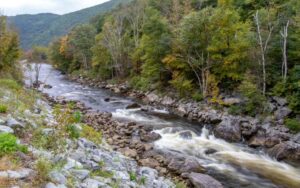
Consistent with the last four years of the survey, MassWildlife biologists will continue to clip the adipose fin of all hatchery-raised brown trout released into the lower section of the Deerfield. “This will enable us to continue monitoring this area and we will know if any hatchery trout make the trip upstream,” says Kautza. “We will continue to monitor the trout population and reassess as needed.”
This survey, along with other fisheries research, allows MassWildlife to manage fish populations more effectively and to provide a variety of fishing opportunities to the public. This project was made possible by ongoing support from the Deerfield River Watershed Chapter of Trout Unlimited and the Greater Boston Chapter of Trout Unlimited. These groups were instrumental in getting this project started and provided physical and financial assistance along the way. “We commend MassWildlife for taking this huge step toward protecting and expanding the wild brown trout population in the upper Deerfield,” says Eric Halloran, president of the Deerfield River Watershed Chapter of Trout Unlimited. “We have known for years that this part of the Deerfield has a significant population of wild brown trout. We hope that through our working relationship with MassWildlife the wild trout population in the Deerfield Watershed will continue to expand.”
Proposed change in goose hunting season
A couple of months ago, it was mentioned in this column that certain waterfowl regulation changes were going to be recommended at a public hearing on April 26. One of the proposed changes would have affected the goose hunters by listing the Berkshire Late Goose season from December 15 to January 30. However; based upon the minutes of the April 2023 Fish & Game Board, they approved a different proposed season which would run from January 1 through February 15.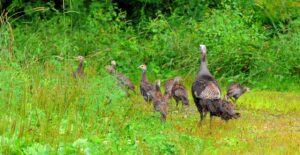
In response to my inquiry for reasons for the change, MassWildlife answered that they did so in response to public comments from hunters, both written and in person at the hearing, Hunters commented that the February portion of the season provides an important opportunity to hunt at a time, and in places, where there is little other activity or conflict with other users. Basically, the Board approved the dates that they felt gave the best opportunity for Berkshire goose hunters.
Ice fishermen expect cold temperatures at that time of year. They need plenty of ice for safety reasons. To counter the cold, they can walk around, chase the tip-ups, cook some warm grub on a hibachi, socialize with other ice fishermen, etc.
But hunkering down and staying still in a small goose blind in February? No, no, not for me.
Pittsfield Sportsmen’s Club youth fishing event
The PSC is sponsoring a kid’s fishing event at Reynolds Pond in Cheshire on Saturday June 17 from 9:00 am to 1:00 pm. It is for kids 12 and under and their parents don’t have to be club members.
There will be snacks for the kids and 5 prizes for kids who catch a tagged trout.
For more information, contact Sandra and Ed Bushey at (413) 443-9371.
Mass Firearm Law Seminar
The Lenox Sportsmen’s Club (LSC) is hosting an educational seminar for both License to Carry Firearms (LTC) holders and non-holders. The Massachusetts Firearm Law Seminar is being held Tuesday, June 13 from 6:00 pm to 9:00 am at the Lenox Sportsmen’s Club, 258 New Lenox Road, Lenox, MA.
Taught by Jon Green, Director of Education & Training for the Massachusetts Gun Owners Action League (GOAL), this 3-hour long seminar reviews and explains both state and federal laws and regulations in simple-to-understand language. The seminar will clarify applicable Massachusetts General Laws (MGL) and Code of Massachusetts Regulations (CMR) regarding;
- Firearm definitions
- Firearm purchase and sale
- Proper and legal firearm and ammunition possession, transport, and storage
- Record-keeping requirements
- Recommended best practices for firearm owners
The cost is $15.00 per person for Lenox Sportsmen’s Club members and their guests and $20.00 for non-members.
Light snacks and soft drinks will be provided. Every attendee will receive a complimentary copy of the Massachusetts Gun Owners Action League firearms law booklet. A License to Carry Firearms (LTC) is not required to attend this seminar.
Pre-Registration is required for this event. People can register on the LSC website.
Hunter education course
Basic hunter education is mandatory for all first-time adult hunters. The Lenox Sportsmen’s Club has scheduled a Hunter Education course at its clubhouse with MassWildlife on August 20. These classes fill up quickly, so if you are interested in taking it, call MassWildlife at (508) 389-7830.
Summer wild turkey survey
Help MassWildlife with its annual summer wild turkey count. Every year from June 1 to August 31, wild turkey reports from the public help their biologists determine productivity, compare long-term reproductive success, and estimate fall harvest potential. Reports are welcome from all regions of Massachusetts, from the most rural communities to more densely-populated areas. The summer wild turkey survey is a fun way for people to connect with nature while contributing valuable data to MassWildlife biologists.
You are encouraged to report wild turkey sightings in your area. Contribute to the annual wild turkey survey by reporting observations of hens (female turkeys), poults (newly-hatched turkeys), jakes (juvenile males), and toms (adult males). Click onto the MassWildlife web page to learn how to tell the difference between male and female turkeys.
Turkey sightings can now be submitted online using a form which can be downloaded. The form has been updated for the 2023 to include a map that allows collection of more accurate location information. Users have the option to zoom to their location on the map or type in an address.
Carp Palooza
This year’s Carp Palooza event will take place on Onota Lake in Pittsfield on June 24. There will be cash prizes for 1st, 2nd and 3rd place, pending the number of entries. Sign-up will take place at the boat ramp between 1:00 and 3:00 pm. Fishing ends at 12:00 am.
Two person teams, $50 per team. Awards will be given for the best combined weight, 2 carp. Lunker Pool optional at $20 per team. Championship belts will be awarded to the first-place team. There will also be a 50/50 raffle.
For information on the event, contact Joshua Christman at (413) 770-7111.
A note from the Environmental Police
According to Lieutenant Tara Carlow of the Massachusetts Environmental Police, officers are patrolling by boat and ATV for violations as well as increasing their presence in the DCR parks as their campgrounds and day use areas become busier. They can always reach out to us for violations or to chat.
Recently they were out with the trout stocking trucks on a couple of occasions and one officer was at the youth stocking event which was recently held at Onota Lake.
So, boaters and anglers take note.
A look back at 2022 Woods and Waters columns
At the end of last year, I highlighted the more informative and interesting articles that were included in this column during the year. Because of positive comments received, I am doing the same for the year 2022.
In January we reported that seventeen women deer hunters participated in MassWildlife’s 2021 Becoming-an-Outdoors-Woman (BOW) Deer Hunt Program. Nearly all the women saw deer and all participants enjoyed their hunt. Two women harvested their first deer ever. We also mentioned a lost Steller’s Sea Eagle (Haliaeetus pelagicus), which is native to Asia. Somehow it found its way to the Taunton River in Massachusetts.
In March there was an article about Bob Leverett “the old growth evangelist”. He informed us that there were indeed old growth forests in Massachusetts. He developed ways for measuring and aging them and their ability to capture carbon. His work, along with that of Dr. Anthony D’Amato (of University of Vermont), have helped to ensure the protection of 1,200 acres of old growth in the Commonwealth’s Forest Reserves. His message is “We have a duty to protect an old-growth forest, for both its beauty and its importance to the planet”. We learned of the death of Leo M Daley who spent some 42 years with the DFW. He had held the titles of Aquatic Biologist, Fisheries Manager, and interim District Manager. In the 30 years spent in our district, he stocked over 1.5 million trout in Western Massachusetts waters.
In March and April there were articles about hungry black bears emerging from their dens and the problems they cause by raiding our bird feeders. In the Berkshires there are about 2,000 of them and readers were advised on how to avoid conflicts with them. MassWildlife Black Bear and Furbearer Biologist Dave Wattles’ study showed that female bears that they study in more suburban areas are very large, with weights averaging more than 250 pounds, compared to bears in more rural, forested areas averaging closer to 150 pounds. A second big takeaway was how close to people bears will den. They had bear dens 10 yards off the back parking lot of a fire department, under a building on piling foundations, on the edge of a backyard, and in the middle of a construction yard. These bears had plenty of options to den in more remote locations but chose not to, indicating bears are finding supplemental food sources in suburban areas, such as unsecured garbage, bird feeders, and open compost. Biologists warn that human food sources are harmful to bears’ natural diets and put communities at added risk of unwanted conflicts.
In April we learned about the numbers and types of wildlife violations that our Massachusetts Environmental Police are dealing with. A pitch was made for Massachusetts to join the Interstate Wildlife Violator Compact, a network that seeks to reduce wildlife poaching through information sharing across state lines and reciprocal recognition of license suspensions and revocations for fishing, hunting, and trapping. The legislation, co-sponsored by Berkshire State Representatives Tricia Farley-Bouvier and Paul Mark, would update the Commonwealth’s outdated penalties for illegal hunting, some of which have not been updated in a century and currently amount to little more than a slap on the hand. The bill passed later this year.
In April we reported that the highly pathogenic Avian Influenza was detected in wild birds in multiple locations in Massachusetts. Avian flu, also known as bird flu, is a common influenza strain that can spread from birds to humans through saliva, naval secretion and feces. The avian flu is not common among humans, but is very contagious among birds. We reported the Preliminary 2021 deer harvest figures verses last year figures:
- Youth Deer/Paraplegic Hunt Days: 86 vs 131 last year
- Archery Season: 5,894 vs 6655 last year
- Shotgun Season: 5,008 vs 5138 last year
- Primitive Firearms Season: 2,375 vs 2842 last year
Although Western Zone harvests were not mentioned, DFW Western District Supervisor Andrew Madden said that they were consistent with 2020 (which was a record year).
In May, 5 individuals received Silvio O. Conte sportsmen awards: The late Chris Puntin, formerly of Pittsfield, received the Sportsman of the Year Award posthumously; Meredyth Babcock of Becket received the Outstanding Achievement Award; Stephanie Dupont of Pittsfield received the Sportsmen’s Appreciation Award; Donald E. Girard of Adams received the Lifetime Achievement Award and Gregg Armstrong, of North Adams, received the John Zuber Award. We also reported that after 38 years of state service, Marion E. Larson retired in early March from her position as Chief of MassWildlife’s Information and Education (I&E) Section. Joshua Christman of Pittsfield, who had been named Massachusetts Angler of the Year (Adult Catch and Keep Category) in 2016, 2020 and 2021 by MassWildlife and a frequent multi-gold pin awardee, was off to another good start this year. He caught a large rainbow trout out of Berkshire waters which measured 24 inches long and weighed 4 lbs.
In June Berkshire Environmental Action Team Executive Director Jane Winn announced that BEAT was awarded $200,000 from the Cultural Facilities Fund of the Massachusetts Cultural Council to renovate their new Environmental Leadership & Education Center. Thirteen-year old Logan Middlebrook of Pittsfield landed a carp out of Pontoosuc Lake which weighed in at 13.3 lbs. and was over 30 inches long. While fighting it he had to cross 2 house lots, a couple of bridges and over people’s docks.
James McGrath, Park, Open Space, and Natural Resource Program Manager, City of Pittsfield announced that the Mill Street dam was successfully removed along with over 8,000 tons of contaminated sediments. Lee Sportsmen’s Association Higher Education Scholarship was awarded to Brianna Kelly. The Bateman Jimmy Fund fishing derby was the greatest with over 355 people in attendance and over $10,000 raised.
In July, Joshua Christman, organizer of Carp Palooza, announced that it was a great event with 39 teams participating. Steve Sears of Dalton was elected Acting Chairman of the MA Fish & Wildlife Board. We featured an article about a Picnic Table Boat. It is powered by an electric motor, and if you run out of power, it has a solar panel on the top of the umbrella which recharges the battery. The battery has a USB port into which they plug in lights, a speaker, an iPad, cooler, etc.
In August we covered the 75th anniversary of the Stockbridge Bowl Association. Feature speaker was the old growth evangelist Bob Leverett. We covered successful flyfishing trips to Labrador and Yellowstone National Park made by local anglers. Eight-year-old Michael (Mikey) Hubbard of Pittsfield successfully landed a 21-inch, 4.4lbs largemouth bass.
In September, Travis Bailey of Lee harvested a bear weighing 620 lbs. field dressed. After it was skinned out, it measured 7 feet from nose to tail, with a space between its ears of 10 inches. Rachel Kanter of Lenox landed a monster 35-inch pike.
In October we reported that It was a good year for MassWildlife/ Department of Fish & Game land acquisitions and conservation completing 11 projects and protecting 937 acres. Great Barrington approved a new ordinance to help curb problem bears.
In November Paraplegic hunters took four deer in the Berkshires, seven statewide. The Youth pheasant hunt produced happy hunters. Some $483,922 was awarded in state grant funds to improve wildlife habitat on 514 acres of land within the Commonwealth.
In December we did an article about MassWildlife’s controlled burns. National Geographic wrote an article titled, ‘This Trail May Be the Best Way to See New England’s Fall Colors”. The specific Berkshires trail mentioned was BNRC’s High Road. The town of Nahant hired sharpshooters to eliminate its coyote problem. DFW Western District Supervisor had a great article in Massachusetts Wildlife about feeding bears.
During the year, we reviewed three books, two by local authors. The Richmond Pond Association and the Richmond Historical Commission produced a book entitled, The Gem of Richmond: A History of Richmond Pond. The editor was Ken Kelly, of Lenox and Richmond. Paul C. Carter of Dalton came out with a new deer hunting book entitled, More Deer Hunts, through a Tracker’s Eyes. Author Robert (Bob) Romano came out with a wonderful book entitled River Flowers. All were still highly recommended.
Thanks for taking the time to read the columns this past year and hopefully you’ll stay with us next year.
Happy New Year!
Carp Palooza Derby was a great success
Carp Palooza is a carp fishing derby that ran on Pontoosuc Lake from 3:00 pm on June 25 until midnight, June 26. Two person teams vied for money and trophies. Some of the trophy titles were: Best Combined Weight, Largest Mirror Carp and the Dink Master Award for the smallest carp caught. Derby rules state that all fish must be weighed and released alive
According to Carp Palooza organizer Joshua Christman, it was a great event with 39 teams participating. Some of them traveled 3 hours to participate even though it was very hot. Special thanks go to Steve Bateman for helping to promote the event.
Christman said that it was non-stop fish weighing from his boat. He gave a huge thank you to his friend Brandon Murray of Pittsfield who also weighed fish from his boat. “Without his help it would not have been possible to keep up”’ said Christman
First place was won by Dan Conant and Mark Dimond with a two Carp weight of 30.6 lbs. Payout for first place was $750. Second place was won by the team of Austin Harvender and Dylan Ladoucer with a two Carp weight of 30.00 Lbs. They went home with $400. Third place was won by Jay Pesci and Scott Rozzay Dickey, and they went home with $200.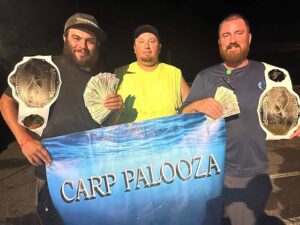
The Lunker Pool payout was $350, and was also won by the first- place team Dan Conant and Mark Dimond. They ended up with $1,100.00 in prizes.
The largest Mirror Carp award went to Robert Houghtlin and Payton Quinn. They won two $25 Dicks Sporting Good’s gift cards and two Carp nets. Even the smallest Carp won a prize. Rebecca Parlato won the Dink Award with a 6 lbs carp. She won a unique trophy and a $25 gift card to Dicks Sporting Goods.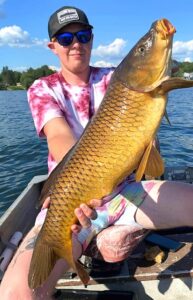
There was another winner – The Jimmy Fund. Some $740 was raised for it and the funds were given to Steve Bateman to remit. Those funds, when added to the funds raised in the Harry Bateman Fishing Derby totaled over $10,740! Thanks to the anglers who participated, to Joshua who organized the event and to all the helpers, contributors and sponsors.
Sponsors of the Carp Palooza Derby are as follows: Private Donations from Christopher Parlato, Becki Grimsley and Ron Mazzeo Jr, Haddad’s (Pittsfield), Wal-Mart (Pittsfield/North Adams), RSI Signs (Pittsfield), Dick’s Sporting Goods (Pittsfield), Undisputed Belt.com, Wristband bros.com, VulgrCo.com and Sticker company.
Josh Christman did a yeoman’s job in putting this derby together. Incidentally, if his name sounds familiar, he has won numerous MA Freshwater Fishing Awards. He was named MA Adult Catch and Keep Angler of the Year in 2016, 2020 and 2021.
Joshua is also owner of Christman Charters.
Antlerless Deer Permit applications due by July 16
If you want to hunt antlerless deer this fall, you need an antlerless deer permit, sometimes called a doe permit. If you apply for a permit by the July 16 deadline, you then must check back after August 1 to find out if you have been awarded the ability to purchase the permit.
Hunters can apply online using MassFishHunt on a computer or smartphone. You need a valid hunting or sporting license to apply for an antlerless deer permit. There is no fee to apply; a $5 fee is charged only if you are awarded a permit during the instant award period.
The instant award period begins August 1 at 8:00 a.m. and ends on December 31. Your odds of being awarded a permit are the same regardless of when you check your permit status. You can check the status of your permit through MassFishHunt.
Because this is a new system, I recommend that you not wait until the last minute to apply. You never know if you will encounter a glitch of some kind.
River Flowers
Author Robert (Bob) Romano has come out with a new book entitled River Flowers.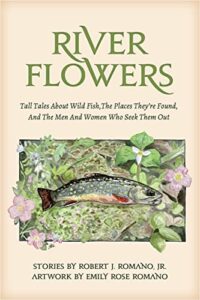
He is author of at least 6 prior books, most of which I have reviewed in this column, simply because I like his writing. Most of his books feature stories about fictional people and the entire book follows what happens to them. They are always based in Western Maine commonly known as the Rangely area.
River Flowers is different in the sense that there are 22 individual short, unrelated stores. But they are all in a way linked together because of where the stories take place, – the Rangely area of Maine.
Romano did not divert from a talent which I really like. Although they are fictional stories with fictional characters, the surrounding scenery of which he writes is far from fictional. When he wrote about the dark forests, the trillium and trout lilies along the pathways, smelling the balsam and spruce and observing the tea -colored streams you know he’s been there, done that. (Actually, Bob should know what he is writing about for he and his family has owned a seasonal cottage there for 40 years).
So, how do you know? If you have ever visited and fished that area you have smelled the aroma of those woods and walked the damp pine needled forest floor, yourself. Not every author can capture and convey those surroundings, but Bob does it perfectly.
Most of his chapters keep you wondering where he is going with the story up until the last page, sometimes the last paragraph.
This book is not for the living room end/coffee table, but rather for your night stand. The chapters are just long enough to get through and then drop off to sleep. No, I assure you the book is not so boring that you fall to sleep before finishing a chapter. But when you nod off after reading a chapter, it almost feels like you are bringing the balsa, spruce and the sound of the flowing rivers into your dreams.
Another thing which strikes me about this book is that even though all ages of readers should enjoy it, it is especially appealing to older (or shall we say experienced) anglers. Not sure if intended, but he writes about things that older anglers, those who have been around a while and are inching toward the riverbend, can relate. In one story, I loved how an angler was thrashing through a dense forest trying to get away from the angling crowds heading toward the sound of a bubbling stream somewhere downhill, hopefully containing wild brook trout. I’m not sure if our younger anglers do that anymore.
But I think the younger generation of anglers will also enjoy this book. It is a great example of how the old anglers used to fish and how the old- time outdoor writers used to write.
One thing which puzzled me about the book was is its name –River Flowers. What’s with that? It wasn’t until nearly the end of the book that he reveals what it is all about. Pretty slick. Clue – it has something to do with Henry David Thoreau.
Having read all of Romano’s books, I find this one his best. I’ve already started reading it again.
It is a soft-cover 217- page book containing 22 stories with artwork by his daughter Emily Rose Romano. It is published by West River Media and costs $25.
Pick one up for grandpa, he’ll enjoy it.
Happy 4th
Here’s hoping that everyone has a safe and enjoyable Fourth of July. As you undoubtedly know, our country has gone through a tough couple of years, with Covid, an insurrection, mass shootings, ridiculous gas and grocery prices and more.
No, we are not a perfect nation, at least not for everyone, but let’s work on that.
Speaking for myself, there is no other place on earth where I would rather live. How about you?

